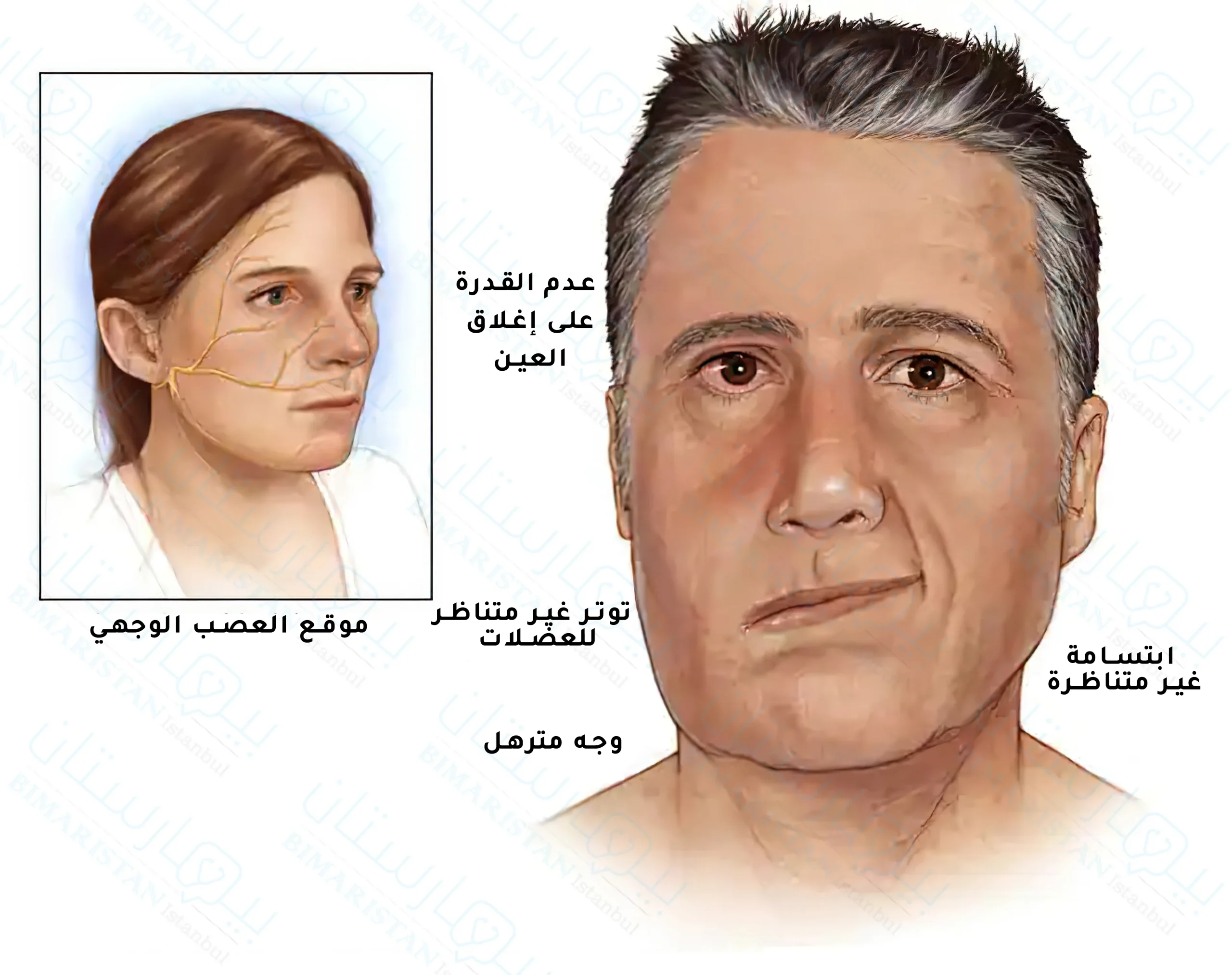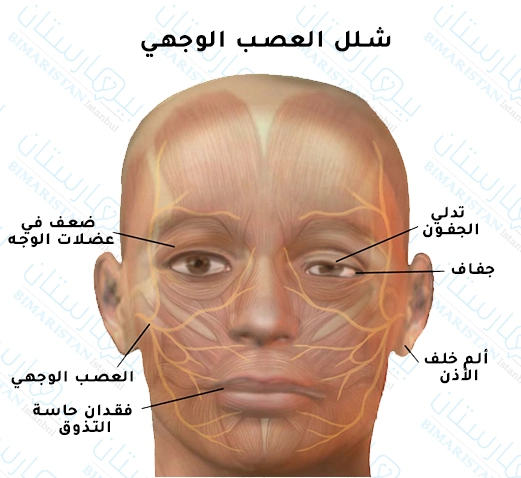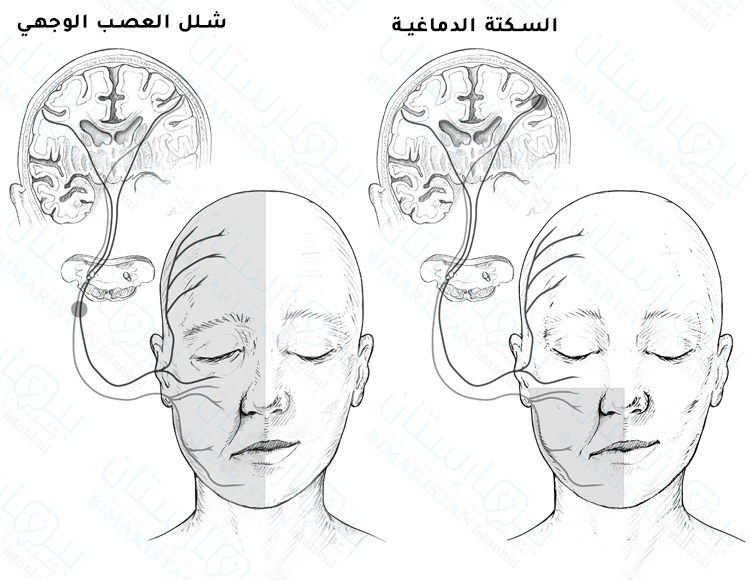شلل العصب الوجهي هو شلل يصيب نصف الوجه، يتعافى معظم الأشخاص تلقائيا في غضون شهر واحد من الإصابة لكن في 30٪ من الحالات يظهر المصابون تعافياً متأخراً أو غير كامل.
ما هو شلل العصب الوجهي السابع؟
اللَّقْوَة، اللُّقَاء، شلل بيل bell’s palsy، الشلل الوجهي facial palsy، شلل العصب القحفي السابع، الشَّلَل الوَجْهِيّ غير معلوم المنشأ، جميعها مسميات لمرض شَلَل العَصَبِ الوَجْهِيِّ facial nerve paralysis، وهو عبارة عن شلل يصيب نصف الوجه، يرافقه في معظم الأحيان ألم خفيف وخدر وفقدان الإحساس بنصف الوجه بالإضافة إلى زيادة الحساسية للصوت وتغير في التذوق.
شلل العصب الوجهي مجهول السبب عادة ولكن قد تكون نسبة من الحالات ناجمة عن فيروس الهربس في العقدة الركبية لعصب الوجه. وهي حالة تؤثر على أحد جانبي الوجه فقط؛ حيث تصبح العضلات في جهة واحدة من الوجه ضعيفة أو مشلولة بشكل مؤقت مما يؤدي إلى تدليها أو تيبسها في هذا الجانب.
يُعد شلل الوجه النصفي أكثر شيوعاً بين الأشخاص الذين تتراوح أعمارهم بين 15 إلى 40 عاماً. يتعافى معظم الأشخاص تلقائياً في غضون شهر واحد من إصابة العصب، لكن في 30٪ من الحالات يظهر المصابون تعافياً متأخراً أو غير كامل.

وللحصول على تشخيص دقيق للمرض يجب أن تعرف أهم أعراضه.
أعراض وعلامات الإصابة بشلل بيل
العلامة الأكثر وضوحاً هي تدلي جانب واحد من وجه المريض وصعوبة إغلاق العين في الجانب المصاب بالإضافة إلى صعوبة الإبتسام وإبراز تعابير الوجه الأخرى. في حالات نادرة يمكن أن يحدث شلل للأعصاب في جانبي الوجه معاً.
إضافةً إلى صعوبة تحريك عضلات الوجه، يمكن ملاحظة بعض الأعراض الأخرى التي تظهر عند المصابين:
- جفاف العين والفم
- الشعور بألم في الفكين أو خلف الأذن وذلك غالباً ما يحدث قبل ظهور الأعراض (من 1 إلى 4 أيام قبل ظهورها)
- صداع
- ضعف في حس التذوق
- طنين الأذنين
- حساسية مفرطة للأصوات حيث تبدو الأصوات أعلى بكثير من المعتاد في الأيام التي تسبق ظهور الأعراض
- صعوبة في التكلم والأكل والشرب

أسباب شلل العصب الوجهي
لا يزال سبب هذه الحالة غير محدد تماماً، لكن يعتقد أن السبب هو حدوث تلف أو التهاب في عصب الوجه مما يؤدي إلى تورم وتضخم فيه، حيث يمر العصب الوجهي عبر منطقة عظمية ضيّقة داخل الجمجمة، و نتيجة لتضخمه ينضغط داخل العظم الصلب المحيط به مما يسبب خلل في عمل هذا العصب.
قد تلعب الالتهابات الفيروسية دوراً في شلل العصب الوجهي، إذ أنّ فيروس الهربس1 (فيروس الحلأ البشري1) هو المسؤول في عدد كبير من الحالات، وهناك بعض الفيروسات الأخرى التي لها صلة بشلل العصب الوجهي:
- الحصبة الألمانية Rubella
- فيروس النكاف Mumps
- الانفلونزا Influenza B
- جدري الماء والقوباء المنطقيةHerpes zoster
- كثرة الوحيدات Epstein-Barr
- الفيروس مضخّم الخلايا Cytomegalovirus
- فيروس مرض اليد والقدم والفم Coxsackievirus
العوامل المؤهبة للإصابة بشلل العصب الوجهي
هنالك العديد من العوامل التي تزيد من احتمالية الإصابة به منها:
- الحمل؛ خاصة خلال الأشهر الثلاثة الأخيرة من الحمل أو في الأسبوع الأول بعد الولادة
- داء السكري؛ حيث أظهرت الدراسات ارتباط داء السكري بارتفاع احتمال الإصابة بهذا الشلل
- بعض أمراض المناعة الذاتية
- قروح البرد
- ارتفاع ضغط الدم
تشخيص شلل العصب الوجهي
لا يوجد اختبار مخبري محدد لتشخيصه وإنما يتم اكتشافه عبر ما يسمى بالتشخيص الإقصائي، وهذا يعني أن الأطباء لا يشخصون الإصابة به إلا بعد استبعاد كل الإحتمالات الأخرى. عادةً ما يتم إجراء فحص بدني كامل وفحص دقيق لعضلات الوجه عن طريق تجريب جميع تعابير الوجه كالإبتسام مثلاً.
قد يطلب الطبيب إجراء تخطيط كهربي عضلي EMG وذلك لقياس النشاط الكهربائي للعضلة. قد يطلب الطبيب أيضاً إجراء الفحص الشعاعي عن طريق الأشعة السينية للجمجمة أو التصوير بالرنين المغناطيسي للتأكد من عدم وجود ورم أو كسر في العظم يضغط على العصب.
علاج شلل العصب الوجهي
يتعافى معظم الأشخاص الذين يعانون من هذه الحالة تلقائياً دون تلقي علاج، قد نلاحظ عند بعض الأشخاص فترة تعافي أطول وفي بعض الحالات النادرة تكون الأعراض دائمة ولكن عادةً ما يحدث التحسن خلال الأسابيع الثلاثة التالية لظهور الأعراض.
هناك بعض العلاجات التي قد تساعد على الشفاء بشكل أسرع مثل الكورتيكوستيروئيدات التي تساعد في تخفيف التورم وتزيد من احتمالية عودة وظيفة الأعصاب إلى طبيعتها ومن ثم تقليل مدة بقاء أعراض الشلل، مع ملاحظة أنها تؤثر بشكل أفضل إذا تم تناولها في غضون 72 ساعة من بدء الأعراض.
قد نحتاج العلاج باستخدام مضادات الفيروسات في حال كانت الأعراض ناجمة عن فيروس الهربس 1 (فيروس الحلأ البشري 1) أو القوباء المنطقية (فيروس جدري الماء النطاقي). إذا كان الشلل يعيق إغلاق العين، فيجب حماية العين المصابة وذلك باستخدام قطرة عينية عقيمة لإبقائها رطبة، كما يجب المواظبة على حركات تدليك الوجه.
لا ينصح بأي تدخل جراحي لعلاج شلل العصب الوجهي إلا إذا استمرت الأعراض مدة طويلة أو عند حصول مضاعفات.
المضاعفات
- أضرار في عصب الوجه
- ضعف عضلات الوجه بشكل دائم
- تقلص في العضلات اللاإرادية
- العمى الجزئي أو الكامل للعين التي لم تغلق بسبب الجفاف المفرط وخدش القرنية
الفرق بين شلل العصب الوجهي والسكتة الدماغية
من المهم معرفة الفرق بين أعراض الإصابة بشلل العصب الوجهي والسكتة الدماغية على الوجه فهما يعتبران أشهر سببين لضعف عضلات الوجه، وفي حين أنَّ شلل العصب السابع حالة غير طارئة فإن السكتة الدماغية تحتاج للإسعاف الطارئ في مستشفى مجهز.
ولذلك فمن المهم أن يتم التقييم الطبي العاجل لأي ضعف مفاجئ بعضلات الوجه لاستبعاد كونه جزء من أعراض السكتة الدماغية خاصة إذا صاحَبها عدم القدرة على رفع الذراع أو صعوبة في التحدث.

في حالة شلل العصب الوجهي نلاحظ اختفاء تجاعيد الجبهة في الجانب المصاب وذلك عند رفع الحاجبين، أما في حالة السكتة الدماغية لا يتم فقد تجاعيد الجبهة في الناحية المتأثرة من الوجه ويكون الشخص قادراً على رفع حاجبه في الناحية المتأثرة بسبب وجود تغذية عصبية مزدوجة قادمة من المخ لهذه المناطق.

لدى معظم الأشخاص يكون شلل العصب الوجهي مرضاً مؤقتاً، بينما عند عدد محدود من المصابين قد يعانون من بعض أعراضه طيلة حياتهم، لذلك وعند الشك بالإصابة بأعراض هذا المرض لاتتردد في طلب استشارة الطبيب المختص، يمكنك التواصل معنا نحن مركز بيمرستان من هنا.
المصادر:
